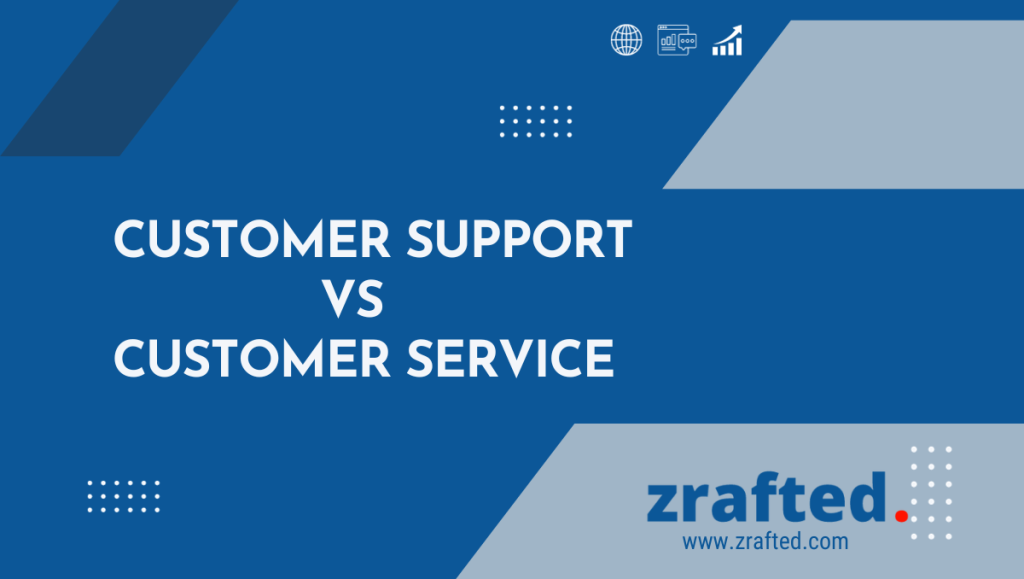Customer Support vs. Customer Service: Understanding the Key Differences
In today’s fast-paced business landscape, providing exceptional customer support and customer service is essential for building lasting relationships with your clientele.
However, these terms are often used interchangeably, leading to confusion and misunderstanding.
So, what is the difference between customer support and customer service? Customer support and customer service are two interconnected yet distinct facets of client engagement. The primary focus of customer support is to effectively handle and resolve any issues or problems that customers may experience in relation to a particular product or service.
Frequently, it necessitates specialised knowledge and tends to be responsive, commencing when clients proactively communicate their particular worries or inquiries.
In contrast, customer service is a more comprehensive notion that encompasses the entirety of the client’s experience. The aforementioned activities encompass proactive engagements that are intended to establish a favourable brand image from the beginning, such as pre-sales inquiries, onboarding processes, and post-purchase follow-ups. Customer service places emphasis on cultivating connections, providing informative materials, and assisting consumers throughout their experience, encompassing more than just resolving issues.

To set the record straight, we’ll delve into the distinctions between customer support and customer service, highlighting their significance in enhancing Customer Experience (CX) and Customer Engagement.
Moreover, we’ll explore the role of Metrics and KPIs, discuss Industry Trends, and emphasize the importance of Customer Feedback in refining these critical aspects of your business.
Unveiling the Differences of Customer Support vs. Customer Service:
Customer Support
Customer support primarily focuses on addressing issues, resolving problems, and providing solutions when customers encounter difficulties with a product or service. It is often reactive, coming into play when customers reach out with specific concerns or queries.
Customer support agents are experts in troubleshooting and resolving technical or operational issues. They play a pivotal role in ensuring that customers can use a product or service effectively and efficiently.
Zrafted, as a customer support and service solution provider, can play a pivotal role in enhancing both aspects of customer interaction.
In terms of hiring professional customer support, Zrafted offers robust tools and technologies to streamline issue resolution, enabling businesses to provide efficient and effective support to their customers.
Additionally, Zrafted’s analytics and reporting capabilities allow businesses to gather valuable insights from customer support interactions, aiding in the identification of recurring issues and areas for improvement.
Key Aspects of Customer Support:
Before discussing the key aspects we’ll first delve into the role of customer support? The primary function of customer support is to offer aid and resolutions to clients in instances where they encounter challenges or possess concerns pertaining to a certain product or service.
Customer support teams are committed to immediately attending to customer inquiries, fixing technical or operational issues, and ensuring a seamless and satisfactory customer experience.
The proficiency and promptness of individuals in their field are of utmost importance in upholding consumer contentment, cultivating reliance, and eventually, preserving a base of devoted clientele.
Customer support is commonly facilitated through a range of communication channels, such as telephone, email, live chat, and ticketing systems, thereby ensuring accessibility to customers seeking assistance.

Issue Resolution:
Customer support teams excel in diagnosing and fixing problems promptly, ensuring minimal disruption to the customer’s experience.
Technical Expertise:
They possess in-depth knowledge of the product or service, enabling them to offer precise solutions.
Availability:
Customer support is typically available through various channels like phone, email, live chat, or ticketing systems to assist customers when needed.
Customer Service
Customer service, on the other hand, is a broader concept that encompasses the entire customer journey.
It involves proactive interactions aimed at creating a positive perception of your brand from the very beginning.
Customer service isn’t limited to problem-solving; it includes activities that enhance the overall experience, such as pre-sales inquiries, onboarding, and post-purchase follow-ups.
In the realm of hiring professional customer service, Zrafted offers to create seamless and personalized customer experiences. By integrating customer data and communication channels, we enable businesses to engage with customers proactively, offering valuable resources, guidance, and information throughout their journey.
This helps to build strong, long-lasting customer relationships and contributes to higher customer satisfaction and engagement.
Key Aspects of Customer Service:
Proactive Engagement:
Customer service teams actively engage with customers to guide them through their journey, providing information and assistance at various touchpoints.
Building Relationships:
They focus on building strong, long-lasting relationships with customers by understanding their needs and preferences.
Educational Resources:
Customer service may offer resources like user guides, tutorials, and FAQs to empower customers to make the most of their purchase.

The Role of Metrics and KPIs in Evaluating Customer Support and Customer Service
To measure the effectiveness of your customer support and service efforts, it’s crucial to establish relevant Metrics and Key Performance Indicators (KPIs). These metrics provide quantifiable insights into your performance, helping you identify areas that require improvement.
Customer Support Metrics and KPIs:
First Contact Resolution (FCR):
The percentage of customer inquiries or issues resolved during the initial contact. A high FCR indicates efficient support.
Average Resolution Time:
The average time it takes to resolve customer issues. Reducing this time enhances customer satisfaction.
Customer Satisfaction (CSAT):
A survey-based metric that gauges customer satisfaction with the support received. Aim for high CSAT scores.
Customer Service Metrics and KPIs:
Net Promoter Score (NPS):
Measures customer loyalty and willingness to recommend your brand. A high NPS indicates satisfied customers who may become promoters.
Customer Effort Score (CES):
Evaluates how easy it is for customers to interact with your brand. Lower effort leads to better customer service.
Churn Rate:
The rate at which customers stop doing business with your company. Lower churn rates signify effective customer service efforts.
Embracing Industry Trends to Enhance Customer Experience
Staying abreast of industry trends is vital to providing top-notch customer support and service. Here are some trends that are shaping the landscape:
1. Omnichannel Support
Customers expect seamless support across multiple channels, including social media, chat apps, and voice assistants. Implementing omnichannel support ensures that customers can engage with your brand using their preferred communication method.
2. AI-Powered Assistance
Artificial intelligence (AI) is revolutionizing customer support and service. Chatbots and virtual assistants can provide instant responses and assistance, improving response times and efficiency.
3. Personalization
Personalized experiences are becoming the norm. Utilize customer data to tailor your support and service interactions, making customers feel valued and understood.

The Vital Role of Customer Feedback
Customer feedback is the lifeblood of continuous improvement in both customer support and service. Soliciting and analyzing feedback allows you to identify areas of improvement and adapt to changing customer preferences. Here’s how to leverage customer feedback effectively:
Surveys: Conduct regular customer satisfaction surveys to gather insights into their experiences.
Feedback Loops:
Create processes for collecting feedback from support interactions and service touchpoints.
Act on Feedback:
Use feedback to make data-driven decisions and implement changes that align with customer expectations.
The Evolution of Customer Support and Customer Service
The landscape of customer support and service has evolved significantly in recent years, driven by technological advancements and changing customer expectations. Understanding these changes can help businesses adapt and thrive in the modern marketplace.
Digital Transformation
One of the most significant shifts in customer support and service is the advent of digital transformation. With the rise of the internet and mobile technology, customers now expect immediate access to information and assistance. This has given rise to the need for 24/7 support and the integration of digital channels, such as chatbots and social media, into customer service strategies.

Businesses that embrace digital transformation can provide faster responses and more personalized experiences, ultimately leading to higher levels of customer satisfaction and engagement.
Data-Driven Decision Making
Data analytics has become a crucial tool in assessing the effectiveness of customer support and service efforts. By analyzing customer interactions, feedback, and behavior, businesses can gain valuable insights into what works and what doesn’t.
For example, tracking customer support interactions can reveal common pain points that may require product or service improvements. Similarly, analyzing customer service interactions can help identify trends and preferences that can inform marketing and product development strategies.
Shift toward Self-Service
Many customers prefer self-service options when seeking information or resolving issues. Self-service portals, knowledge bases, and FAQs empower customers to find answers to their questions independently. This not only enhances the customer experience by providing immediate solutions but also reduces the workload on support and service teams.
To excel in this area, businesses must invest in creating comprehensive self-service resources and ensuring they are easily accessible and user-friendly.
The Importance of Seamless Integration
To provide a holistic and effective customer experience, businesses should aim for seamless integration between customer support and customer service. This involves breaking down silos between departments and creating a unified approach to customer interactions.
For instance, when a customer contacts support with a technical issue, the support agent should have access to the customer’s service history and previous interactions. This enables them to provide a more personalized and efficient resolution.
Additionally, customer service teams can benefit from insights gained by customer support interactions. Understanding common issues or pain points can inform product improvements and marketing strategies, ensuring a better overall customer experience.
Conclusion:
In conclusion, customer support and customer service play distinct but complementary roles in delivering exceptional customer experiences and fostering customer engagement.
By understanding these differences and leveraging relevant metrics, staying attuned to industry trends, and actively seeking customer feedback, you can continually refine your strategies to meet and exceed customer expectations. In doing so, you’ll build stronger customer relationships and drive business success.
Remember, in today’s competitive landscape, the customer’s experience with your brand can be the deciding factor that sets you apart from the competition. Prioritizing customer support and service is not just good practice; it’s a strategic imperative.
Lorem ipsum dolor sit amet, consectetur adipiscing elit. Ut elit tellus, luctus nec ullamcorper mattis, pulvinar dapibus leo.





